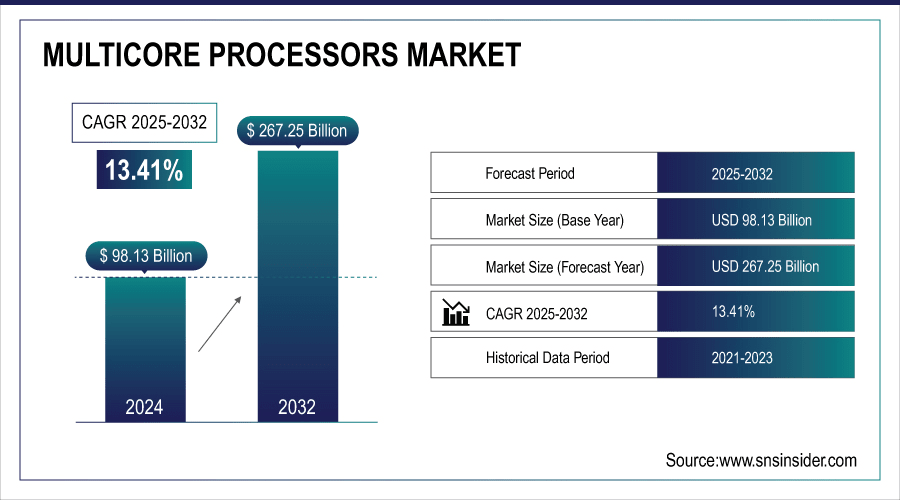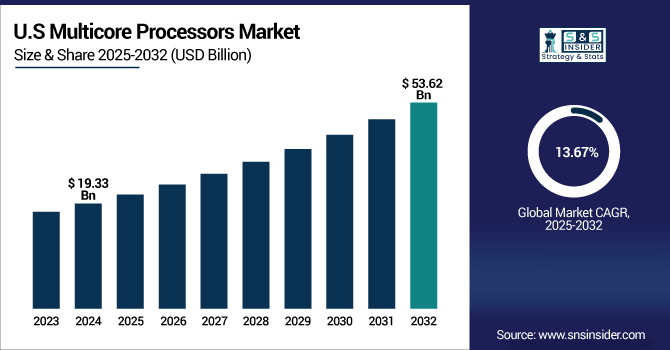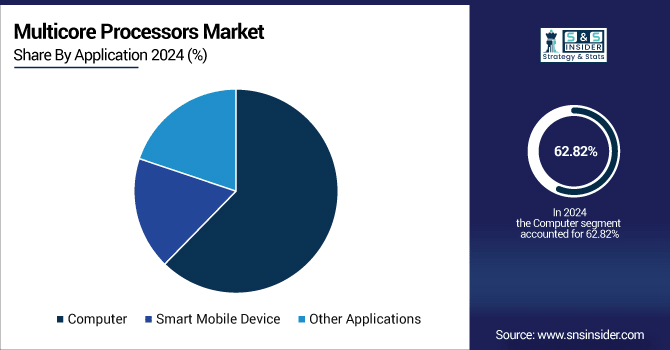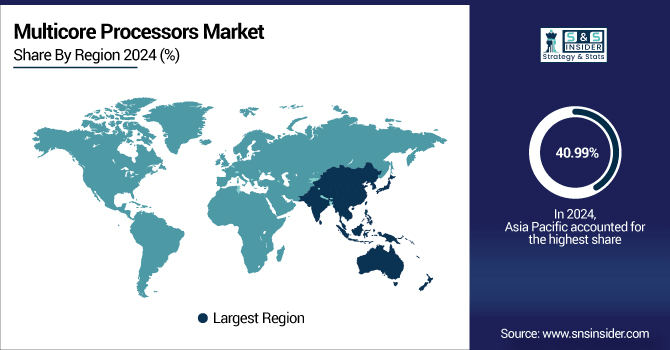Multicore Processors Market Size & Growth:
The Multicore Processors Market Size was valued at USD 98.13 billion in 2024 and is expected to reach USD 267.25 billion by 2032 and grow at a CAGR of 13.41% over the forecast period 2025-2032.

To Get More Information On Multicore Processors Market - Request Free Sample Report
The global Multicore Processors Market is witnessing positive growth with growth being driven by surging need for high performance computing in all industry verticals. Technology advancements, growing adoption in consumer electronics, automobiles, and telecommunications, and the demand for power-efficient solutions are driving the market growth. Improved processing performance and parallel computing advantages are further driving the demand for the market through the forecast period.
According to research,Multicore processors offer up to 50% faster processing and 30% better energy efficiency compared to traditional single-core processors.
The U.S. Multicore Processors Market size was USD 19.33 billion in 2024 and is expected to reach USD 53.62 billion by 2032, growing at a CAGR of 13.67% over the forecast period of 2025–2032.

The U.S. Market is experiencing strong growth driven by improvements in semiconductor technology and expanding usage across diverse industries. Rising needs for high-speed data processing, AI uses, and cloud computing are driving demand at a faster pace. Moreover, government spending and investments in technology innovation also underpin growth of the market, placing the U.S. as a strategic center for multicore processor development and deployment.
According to research, over 80% of U.S.-based tech companies are actively integrating multicore processors into their product lines to support AI and data-intensive applications.
Multi-Core Processors Market Dynamics
Key Drivers:
-
Increasing Adoption of High-Performance Computing and Parallel Processing in Consumer Electronics and Automotive Industries Accelerates Market Expansion
Growing need for added computational strength within consumer and automobile products is the primary trend mover for multicore processors' markets. Consumers also require gadgets like smartphones, video game systems, and electric vehicles to use the efficient parallelism capabilities of multitasking as such complex work includes AI tasks, graphics handling, and analyzing data in real time. For the same purpose, manufacturers seek developing sophisticated multicore designs, thereby providing greater functionality, performance improvement, reduced energy consumption, and scalability.
According to research, over 75% of new smartphones launched in 2024 feature AI-enabled multicore processors.
Restrain:
-
Limited Compatibility Issues with Legacy Software Hindering Seamless Integration of Multicore Processors Across Industries
Legacy software tends to have problems maximizing multicore processor capabilities, therefore, developing compatibility issues that limit market expansion. Most applications currently developed are compatible with single-core or less complex architectures and hence result in wasteful performance or additional development expenses when they are tailored for multicore environments. Such incompatibility retards adoption, particularly in legacy-dependent industries. The necessity of a lot of software optimization and reengineering to exploit multicore benefits poses a critical challenge, curbing the hassle-free adoption and large-scale penetration of multicore processors in diverse industries.
Opportunities:
-
Rising Demand for Energy-Efficient Multicore Processors in Edge Computing and IoT Applications Creates New Market Prospects
High demand of power-efficient multi-core processors as the explosive expansion of edge computing and IoT devices. Such applications require processors that can manage multiple concurrent threads with energy efficiency, in order to achieve long battery life, and to minimize heat dissipation. Complementing this trend, vendors can leverage multicore to create specialized solutions targeted at smart devices, industrial automation, and wearables. This emerging demand creates great opportunities for innovation and market development.
According to research, Energy-efficient multicore processors reduce power consumption by up to 40%, extending battery life in portable devices.
Challenges:
-
Ensuring Security and Mitigating Vulnerabilities in Complex Multicore Architectures Presents Major Industry Challenges
With the increasing complexity of multicore processors, security vulnerabilities are a major challenge to address. The various cores and the complex interconnects introduce possible attack sites for cyber attacks like side-channel attacks and data breaches. Ensuring robust security while maintaining performance is difficult and requires continuous innovation in hardware and software security measures. Failure to effectively manage these risks can lead to reduced consumer confidence and regulatory hurdles, posing a major obstacle to widespread adoption and growth in the multicore processors market.
Multicore Processor Market Segment Analysis:
By Type
The Octa Core Processors segment dominated the highest revenue market share of 39.06% in 2024 due to its better performance in multitasking and power efficiency. Top players such as Qualcomm and MediaTek have rolled out enhanced octa-core chipsets such as the Snapdragon 8 Gen series and Dimensity 9000, enhancing adoption in smartphones and IoT devices. These advancements further establish the segment's leadership in the multicore processors industry, responding to increasing demand for high-speed, low-power computing in consumer electronics and the automotive industries.
The Octa Core Processors segment is expected to have the fastest CAGR of 13.71% between 2025 and 2032, driven by ongoing innovation and increasing adoption across mobile and embedded applications. Primary launches such as Samsung's Exynos 2200 and Apple's A15 Bionic with high-performance octa-core setups drive this rapid development. The trend mirrors overall multicore processors market growth as consumers and businesses increasingly look for efficient, high-performance solutions in AI, gaming, and edge computing.
By Application
The Computer segment dominated the highest revenue share of 62.82% in 2024, led by the increased demand for high-performance processors in workstations and servers. Advancements from players such as Lenovo and Dell, incorporating advanced multicore processors into their computers, have improved processing speeds and multitasking functionality. This spike sustains sophisticated applications such as AI, big data analysis, and virtual reality, making the computer segment a leader in the overall multicore processors market.

The Smart Mobile Device segment is expected to have the fastest CAGR of 14.49% from 2025 to 2032, driven by smart wearables and smartphone penetration growth. Multicore processors companies such as Oppo and Xiaomi have introduced products with optimized multicore processors, balancing performance and battery life. This is in accordance with the expanding market, as the need for more powerful mobile computation and energy efficiency will continue to increase globally.
By End-User
The Automotive segment dominated the multicore processors market share of 32.95% in 2024 due to the growing adoption of advanced driver-assistance systems (ADAS) and autonomous driving features. Players such as NXP Semiconductors and Renesas Electronics have released specialized multicore processors in the automotive grade for real-time processing and safety. These innovations promote the need for intelligent, safer vehicles, securing the automotive sector's pivotal position in the overall multicore processors market growth.
The Consumer Electronics segment is expected to have the fastest CAGR of 15.13% during 2025-2032, led by increased demand for smart home appliances, gaming consoles, and augmented reality devices. Sony and Asus have launched new-age products with powerful multicore processors that provide improved user experience and multitasking features. Such fast growth is indicative of the growing market, driven by consumer demand for high-performance, networked electronics with better energy efficiency.
Multicore Processors Market Regional Analysis:
The Asia Pacific region dominated the highest revenue share of 40.99% in 2024, due to rapid industrialization and technology adoption in countries like China, India, and South Korea. Companies like HiSilicon and Samsung have come out with advanced multicore processors exclusively for smartphones, IoT, and automotive applications. Such robust product development supports the top position, continuing Asia Pacific's key role in the world market through strong demand and production capacity.

Get Customized Report as Per Your Business Requirement - Enquiry Now
-
China dominated the Asia Pacific semiconductor market with its massive investment in manufacturing capacity, government strategic policies like the "Made in China 2025" initiative, and high domestic demand in various industries. Its focus on becoming independent in semiconductors and innovation made it a global leader in semiconductor production and consumption.
The North America market is expected to have the fastest CAGR of 14.46% between 2025 and 2032, owing to high investments in defense, AI, and cloud computing industries. Companies like NVIDIA and Texas Instruments driving innovation through the launch of advanced multicore processors for data centers and edge computing are fueling this growth. This is complemented by the growing market in North America, where technological progress and early adoption spur market penetration and revenues.
-
The U.S. leads North America's market thanks to its robust technology infrastructure, top-ranked semiconductor firms, and government policies promoting innovation. Strategic centers such as Silicon Valley fuel research and development, drawing investments and fueling advances in processor technologies across sectors.
Europe's market is growing steadily with the push from automotive electronics, industrial automation, and smart technologies. Germany and the UK are promoting innovation through strong R&D environments and partnerships. The region's emphasis on AI, 5G, and IoT applications, coupled with favorable regulations and digital transformation efforts, keeps it increasingly competitive in the global marketplace.
-
Germany is the top nation in Europe's multicore processors market due to its strong industrial foundation, heavy investments in cloud computing and AI, as well as the development of sophisticated data centers. The nation's emphasis on technological advancement and high data privacy levels further supports its dominance within the region.
Saudi Arabia holds its position in the Middle East & Africa market because of the significant investments made in digital transformation and smart city projects. Brazil is the market leader in Latin America with an emerging tech infrastructure, growing adoption of cloud, and rising data centers to enable advanced computing and processor technologies.
Multicore Processor Companies are:
Major Key Players in Multicore Processors Market are Intel Corporation, Advanced Micro Devices, Inc. (AMD), Qualcomm Technologies, Inc., NVIDIA Corporation, MediaTek Inc., Samsung Electronics Co., Ltd., Apple Inc., Broadcom Inc., Texas Instruments Incorporated, NXP Semiconductors N.V. and others.
Recent Trends:
-
In November 2023, MediaTek announced the Dimensity 9300, its latest flagship chipset featuring an all-big core CPU design and a 12-core Immortalis-G720 GPU with hardware-based ray tracing. The chipset offers a 40% improvement in peak performance compared to its predecessor while using 33% less power.
-
In November 2023, Apple's M3 Max chip, built on a 3nm process, powers the latest MacBook Pro models. It offers significant performance and efficiency improvements, catering to professional users requiring high computational power.
| Report Attributes | Details |
|---|---|
| Market Size in 2024 | USD 98.13 Billion |
| Market Size by 2032 | USD 267.25 Billion |
| CAGR | CAGR of 13.41% From 2025 to 2032 |
| Base Year | 2024 |
| Forecast Period | 2025-2032 |
| Historical Data | 2021-2023 |
| Report Scope & Coverage | Market Size, Segments Analysis, Competitive Landscape, Regional Analysis, DROC & SWOT Analysis, Forecast Outlook |
| Key Segments | • By Type (Octa Core Processors, Hexa Core Processors, Quad Core Processors, Dual Core Processors) • By Application (Computer, Smart Mobile Device, Other Applications) • By End-User(Consumer Electronics, Automotive, Telecommunications, Healthcare, Other) |
| Regional Analysis/Coverage | North America (US, Canada, Mexico), Europe (Germany, France, UK, Italy, Spain, Poland, Turkey, Rest of Europe), Asia Pacific (China, India, Japan, South Korea, Singapore, Australia, Rest of Asia Pacific), Middle East & Africa (UAE, Saudi Arabia, Qatar, South Africa, Rest of Middle East & Africa), Latin America (Brazil, Argentina, Rest of Latin America) |
| Company Profiles | Intel Corporation, Advanced Micro Devices, Inc. (AMD), Qualcomm Technologies, Inc., NVIDIA Corporation, MediaTek Inc., Samsung Electronics Co., Ltd., Apple Inc., Broadcom Inc., Texas Instruments Incorporated, NXP Semiconductors N.V. |

